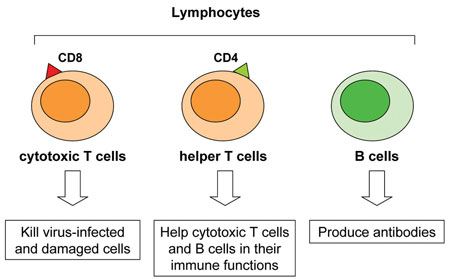Lymphocytes and the immune response to infection
We will now describe how the immune system attacks a virus (such as HIV), but note that similar processes occur when bacteria and protozoa invade the human body. The most important group of white blood cells in our defence against infection are the lymphocytes, of which there are several types (figure below). Lymphocytes called B cells are responsible for producing special proteins called antibodies against the invading infectious agents. Antibodies are proteins that bind to viruses (and other infectious agents), attracting other types of lymphocyte (we have called them cytotoxic T cells in the figure below) to come and destroy the invaders. Viruses can only multiply inside the body's own cells, so destroying our own body cells if they have been infected by viruses is a price worth paying, because it slows down the production of more viruses.
Cytotoxic means 'able to kill cells'.
Most importantly, the helper T cells in the figure above 'help' all the other cells of the immune system to make antibodies and attack invading infectious agents. These cells are also known as CD4 lymphocytes (or CD4 cells) because they have a special protein on their surface called CD4. Without a large number of CD4 lymphocytes circulating around the body acting as 'helpers', the functioning of the whole immune system collapses, and the person is defenceless against invasion by infectious agents.
